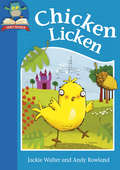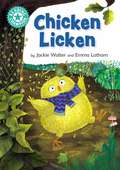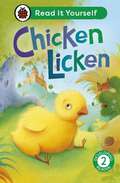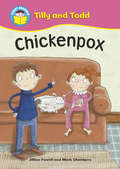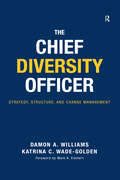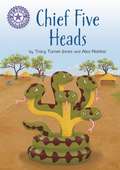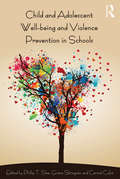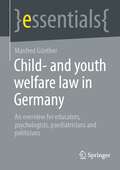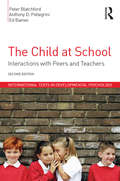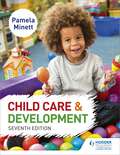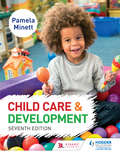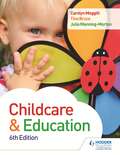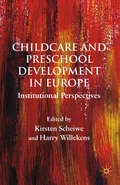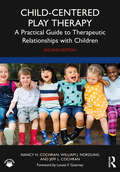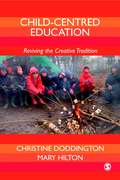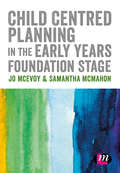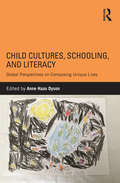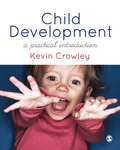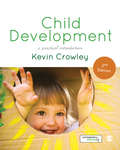- Table View
- List View
Chicken Licken: Level 1: Chicken Licken Must Know Stories: Level 1: Chicken (Must Know Stories: Level 1)
by Jackie Walter"The sky is falling in!" That's what silly young Chicken Licken thinks when an acorn falls on her head. She rushes off to tell the king. But will she ever reach the palace?A beautifully illustrated retelling of this favourite traditional story.Must Know Stories includes favourite tales, celebrating the diversity of our literary heritage. Level 1 stories are told in under 500 words, for children to read independently.
Chicken Licken: Independent Reading Turquoise 7 (Reading Champion #559)
by Jackie WalterWhen an acorn drops on the head of Chicken Licken, he is sure the sky is falling. He sets off to tell the king all about it.This story is part of Reading Champion, a series carefully linked to book bands to encourage independent reading skills, developed with Dr Sue Bodman and Glen Franklin of UCL Institute of Education (IOE)Reading Champion offers independent reading books for children to practise and reinforce their developing reading skills.Fantastic, original stories are accompanied by engaging artwork and a reading activity. Each book has been carefully graded so that it can be matched to a child's reading ability, encouraging reading for pleasure.
Chicken Licken: Read It Yourself - Level 2 Developing Reader (Read It Yourself)
by LadybirdBased on the much-loved classic tale. Chicken Licken and his friends set off to warn the king that the sky is falling down. Little do they know, someone is following them . . . Will the feathered friends make it to the castle safe and sound?Chicken Licken is from Developing Reader Level 2 and is ideal for readers aged from 5+ who can read short, simple sentences with help.Each book has been carefully checked by educational and subject consultants and includes comprehension puzzles, book band information, and tips for helping children with their reading.With five levels to take children from first phonics to fluent reading and a wide range of different stories and topics for every interest, Read It Yourself helps children build their confidence and begin reading for pleasure.
Chickenpox: Tilly And Todd: Chickenpox (Start Reading: Tilly And Todd #2)
by Jillian PowellTilly has chicken pox, but how can the family get her to stop itching?
The Chief Diversity Officer: Strategy Structure, and Change Management
by Damon A. Williams Katrina C. Wade-GoldenThis volume addresses the role of chief diversity officers as coordinating and integrating diversity leaders in higher education and other sectors.Having established in a companion volume the parameters for an effective diversity strategy, the authors address such questions as: What is a chief diversity officer? How might we create dynamic chief diversity officer infrastructures? What models of CDO structure exist in the academy? What misperceptions often confound the work of officers and the institutions they work within? What key competencies are necessary to lead as a CDO? How does the CDO role compare across higher education, non-profit, and corporate sectors? And how might the role serve as an important contributor to a collaborative vision for change and transformation in the academy?This book begins by delineating the evolution of the chief diversity officer role in the academy. Drawing on extensive qualitative and quantitative research on CDOs conducted for the purposes of this volume, it describes how the scope and responsibilities are variously defined at the organizations where the position has been created, and offers insights into the complexities and challenges of the role.On the basis of this data and the literature on organizational design and change management, the authors define the requisite skills, knowledge and background to be effective, review the alternative organizational and governance structures under which CDOs operate, and in so doing present the Chief Diversity Officer Development Framework as a basis for recruiting candidates, for structuring the position to succeed, and for providing prospective and incumbent CDOs with a realistic sense of the scope of the role.This title is also available in a set with its companion volume, Strategic Diversity Leadership.
The Chief Diversity Officer: Strategy Structure, and Change Management
by Damon A. Williams Katrina C. Wade-GoldenThis volume addresses the role of chief diversity officers as coordinating and integrating diversity leaders in higher education and other sectors.Having established in a companion volume the parameters for an effective diversity strategy, the authors address such questions as: What is a chief diversity officer? How might we create dynamic chief diversity officer infrastructures? What models of CDO structure exist in the academy? What misperceptions often confound the work of officers and the institutions they work within? What key competencies are necessary to lead as a CDO? How does the CDO role compare across higher education, non-profit, and corporate sectors? And how might the role serve as an important contributor to a collaborative vision for change and transformation in the academy?This book begins by delineating the evolution of the chief diversity officer role in the academy. Drawing on extensive qualitative and quantitative research on CDOs conducted for the purposes of this volume, it describes how the scope and responsibilities are variously defined at the organizations where the position has been created, and offers insights into the complexities and challenges of the role.On the basis of this data and the literature on organizational design and change management, the authors define the requisite skills, knowledge and background to be effective, review the alternative organizational and governance structures under which CDOs operate, and in so doing present the Chief Diversity Officer Development Framework as a basis for recruiting candidates, for structuring the position to succeed, and for providing prospective and incumbent CDOs with a realistic sense of the scope of the role.This title is also available in a set with its companion volume, Strategic Diversity Leadership.
Child and Adolescent Wellbeing and Violence Prevention in Schools
by Phillip T. Slee Grace Skrzypiec Carmel CefaiThis invaluable book offers a comprehensive guide for educators in understanding and promoting wellbeing and violence prevention initiatives in schools and communities. Ittranslates research and theory into practice with a strong evidence-based application. The book is presented in five thematic sections, namely: culture and wellbeing; young females and wellbeing; bullying; cyberbullying and student violence; interventions to promote wellbeing; and interventions to promote violence prevention. An introductory chapter provides an overview of the field and a commentary chapter draws the five themes together. Written by experienced researchers and educators, each of the 21 chapters provides practical information and research on school, classroom or community applications, trends and issues in the field, and practical ideas for wellbeing and violence prevention measures. Issues of culture, gender and youth voice are specifically addressed.
Child and Adolescent Wellbeing and Violence Prevention in Schools
by Phillip T. Slee Grace Skrzypiec Carmel CefaiThis invaluable book offers a comprehensive guide for educators in understanding and promoting wellbeing and violence prevention initiatives in schools and communities. Ittranslates research and theory into practice with a strong evidence-based application. The book is presented in five thematic sections, namely: culture and wellbeing; young females and wellbeing; bullying; cyberbullying and student violence; interventions to promote wellbeing; and interventions to promote violence prevention. An introductory chapter provides an overview of the field and a commentary chapter draws the five themes together. Written by experienced researchers and educators, each of the 21 chapters provides practical information and research on school, classroom or community applications, trends and issues in the field, and practical ideas for wellbeing and violence prevention measures. Issues of culture, gender and youth voice are specifically addressed.
Child- and youth welfare law in Germany: An overview for educators, psychologists, paediatricians and politicians (essentials)
by Manfred GüntherTaking into account the KJSG of June 2021, the author presents child and youth law with SGB VIII at its centre in a clear and compact manner. Analyses and commentary appear consistently up-to-date and comprehensible, as he largely dispenses with legalese. Readers - custodial parents, other guardians, young people concerned, social educators in institutions, students - and last but not least the committed "lobbyists" in the youth welfare committees - are thus provided with a quick, profound overview of the essential policy and practice-relevant positions; the focus is on legal entitlements: offers, services as well as important and useful general regulations of the German Social Code for Child and Youth Welfare.
The Child at School: Interactions with peers and teachers, 2nd Edition (International Texts in Developmental Psychology)
by Peter Blatchford Ed Baines Anthony D. PellegriniWhat is the nature of children’s social life in school? How do their relationships and interactions with peers, teachers and other school staff influence their development and experience of school? This book, written by leading researchers in educational and developmental psychology, provides answers to these questions by offering an integrated perspective on children’s social interactions and relationships with their peers and teachers in school. Peer interactions in school have tended to be underestimated by educationalists, and this book redresses the balance by giving them equal weight to teacher–child interactions. In this second edition, the authors extensively revise the text on the basis of many years of research and teaching experience. They highlight common misconceptions about children, their social lives, and school achievement which have often resulted in ineffective school policy. The book includes a number of important topics, including: The significance of peer-friendships at school?? The nature and importance of play and break-times Aggression and bullying at school?? Peer relations and learning at school The classroom environment and teacher-pupil interaction?? The influence of gender in how children learn at school.?? Advantages and disadvantages of different methodological approaches for studying children in school settings Policy implications of current research findings. The Child at School will be essential reading for all students of child development and educational psychology. It will also be an invaluable source for both trainee and practicing teachers and teaching assistants, as well as clinical psychologists and policy makers in this area.
The Child at School: Interactions with peers and teachers, 2nd Edition (International Texts in Developmental Psychology)
by Peter Blatchford Ed Baines Anthony D. PellegriniWhat is the nature of children’s social life in school? How do their relationships and interactions with peers, teachers and other school staff influence their development and experience of school? This book, written by leading researchers in educational and developmental psychology, provides answers to these questions by offering an integrated perspective on children’s social interactions and relationships with their peers and teachers in school. Peer interactions in school have tended to be underestimated by educationalists, and this book redresses the balance by giving them equal weight to teacher–child interactions. In this second edition, the authors extensively revise the text on the basis of many years of research and teaching experience. They highlight common misconceptions about children, their social lives, and school achievement which have often resulted in ineffective school policy. The book includes a number of important topics, including: The significance of peer-friendships at school?? The nature and importance of play and break-times Aggression and bullying at school?? Peer relations and learning at school The classroom environment and teacher-pupil interaction?? The influence of gender in how children learn at school.?? Advantages and disadvantages of different methodological approaches for studying children in school settings Policy implications of current research findings. The Child at School will be essential reading for all students of child development and educational psychology. It will also be an invaluable source for both trainee and practicing teachers and teaching assistants, as well as clinical psychologists and policy makers in this area.
Child Care and Development 7th Edition
by Pamela MinettDeliver a detailed and focused Child Development course with the 7th edition of this textbook from Pamela Minett, designed to cover all the relevant topics in concise and highly illustrated chapters. - Quickly access individual topic areas with concise, focused and clearly laid out chapters.- Build knowledge and understanding with ongoing summative questions at the end of each chapter.- Engage learners with 100s of illustrations and photographs to support understanding of key concepts.- Suitable for all Level 1 and Level 2 specifications.
Child Care and Development (7th Edition) (PDF)
by Pamela MinettDeliver a detailed and focused Child Development course with the 7th edition of this textbook from Pamela Minett, designed to cover all the relevant topics in concise and highly illustrated chapters. - Quickly access individual topic areas with concise, focused and clearly laid out chapters.- Build knowledge and understanding with ongoing summative questions at the end of each chapter.- Engage learners with 100s of illustrations and photographs to support understanding of key concepts.- Suitable for all Level 1 and Level 2 specifications.
Child Care and Education 6th Edition
by Carolyn Meggitt Julia Manning-Morton Tina BruceDeliver an in depth programme of teaching for level 3 and level 4 with this classic textbook that inspires your students to go further.Written by an expert team of childcare authors, the sixth edition of this classic textbook offers an in-depth approach to Childcare and Early Years study unmatched by any course specific texts. Child Care and Education 6th Edition provides full details of all the topics and frameworks relevant to level 3 and level 4 qualifications. It offers the opportunity to analyse and explore theories and practice at a high level of detail.- Provides post level 3 material in clearly marked 'Moving On' sections at the end of each chapter.- Focuses on the practicalities of working within a real-life setting using case studies and observation tasks.- Suitable for level 3 qualifications and courses that bridge the gap between levels 3 and 4.
Child Care and Preschool Development in Europe: Institutional Perspectives
by K. Scheiwe H. WillekensThis book explains the differences between European countries in the supply and forms of public child care and preschool provisions by reference to the historical context in which these forms originated and to the institutional constraints underlying their development.
Child-Centered Play Therapy: A Practical Guide to Therapeutic Relationships with Children
by Nancy H. Cochran William J. Nordling Jeff L. CochranDesigned for professionals adding play therapy to their practices as well as for graduate students, the second edition of Child-Centered Play Therapy is comprehensive, engaging, and practical. The authors provide a strong theoretical base from which to understand the whys and hows of child-centered play therapy and guide readers through all necessary skills for successful practice. From playroom setup, tracking and empathy, limit-setting, and role-play to treatment planning, recognizing stages, measuring progress, and working with parents and teachers, each chapter anticipates readers’ questions and covers key concepts in diverse ways to meet different learning styles. On the book’s website, readers will find a test bank, sample slides and syllabi, treatment planning forms, as well as additional activities and worksheets for students and trainees. Key Features: Everything needed for best practices in child-centered play therapy in one book. Plain-spoken, practical writing. Vivid case stories and vignettes. New neuroscience findings linked to long-held wisdoms of child-centered play therapists. Outcome research reviewed across problem areas of externalizing and internalizing behaviors, school problems, applications with children with disabilities, adverse childhood experiences, and trauma. Endorsed by Louise Guerney, a founding child-centered play therapy figure who developed the skills-based methods covered in this book, Child-Centered Play Therapy comprehensively and realistically introduces practitioners to the child-centered approach to play therapy and addresses how to incorporate the approach into schools, agencies, or private practice.
Child-Centered Play Therapy: A Practical Guide to Therapeutic Relationships with Children
by Nancy H. Cochran William J. Nordling Jeff L. CochranDesigned for professionals adding play therapy to their practices as well as for graduate students, the second edition of Child-Centered Play Therapy is comprehensive, engaging, and practical. The authors provide a strong theoretical base from which to understand the whys and hows of child-centered play therapy and guide readers through all necessary skills for successful practice. From playroom setup, tracking and empathy, limit-setting, and role-play to treatment planning, recognizing stages, measuring progress, and working with parents and teachers, each chapter anticipates readers’ questions and covers key concepts in diverse ways to meet different learning styles. On the book’s website, readers will find a test bank, sample slides and syllabi, treatment planning forms, as well as additional activities and worksheets for students and trainees. Key Features: Everything needed for best practices in child-centered play therapy in one book. Plain-spoken, practical writing. Vivid case stories and vignettes. New neuroscience findings linked to long-held wisdoms of child-centered play therapists. Outcome research reviewed across problem areas of externalizing and internalizing behaviors, school problems, applications with children with disabilities, adverse childhood experiences, and trauma. Endorsed by Louise Guerney, a founding child-centered play therapy figure who developed the skills-based methods covered in this book, Child-Centered Play Therapy comprehensively and realistically introduces practitioners to the child-centered approach to play therapy and addresses how to incorporate the approach into schools, agencies, or private practice.
Child-Centred Education: Reviving the Creative Tradition (PDF)
by Mary Hilton Ms Christine DoddingtonAgainst an increasingly authoritarian background of testing and instruction, concern is growing about disengagement and loss of depth and quality in education at all levels. Child Centred Education seeks to explore the role of Primary education within this debate. The book will inspire teachers and head teachers seeking to make their practice more genuinely educational. The authors capture the current opinion that primary schools can begin to reclaim some of their autonomy, be innovative and become more creative. Based on wide ranging research, the book sets out to revive the creative alternative to the rigid and impoverished learning experienced by too many primary school children. The authors: - Trace the origins and history of the child-centred tradition - Set out its fundamental beliefs and values - Explore its place in education today This book is for teachers, school governors, local authority officers, undergraduate and postgraduate teacher training, and professional development courses.
Child Centred Planning in the Early Years Foundation Stage
by Jo McEvoy Samantha McMahonPlanning for learning in the EYFS is not a simple task. Planning can be daunting, time consuming and ineffective. It is easy to fall into the trap of planning for activities and topics, rather than planning for learning. Be better, more confident and effective at planning for learning in the EYFS with this book. *Explore the wider context of children's learning *Make professional, informed decisions to support all children *Use statutory and non-statutory guidance appropriately *Be responsive to children's individual needs *Capitalize on learning opportunities as they arise *Be an advocate for child-centred planning
Child Centred Planning in the Early Years Foundation Stage
by Samantha McMahon Jo McEvoyPlanning for learning in the EYFS is not a simple task. Planning can be daunting, time consuming and ineffective. It is easy to fall into the trap of planning for activities and topics, rather than planning for learning. Be better, more confident and effective at planning for learning in the EYFS with this book. *Explore the wider context of children's learning *Make professional, informed decisions to support all children *Use statutory and non-statutory guidance appropriately *Be responsive to children's individual needs *Capitalize on learning opportunities as they arise *Be an advocate for child-centred planning
Child Cultures, Schooling, and Literacy: Global Perspectives on Composing Unique Lives
by Anne Haas DysonThrough analysis of case studies of young children (ages 3 to 8 years), situated in different geographic, cultural, linguistic, political, and socioeconomic sites on six continents, this book examines the interplay of childhoods, schooling, and, literacies. Written language is situated within particular childhoods as they unfold in school. A key focus is on children’s agency in the construction of their own childhoods. The book generates diverse perspectives on what written language may mean for childhoods. Looking at variations in the complex relationships between official (curricular) visions and unofficial (child-initiated) visions of relevant composing practices and appropriate cultural resources, it offers, first, insight into how those relationships may change over time and space as children move through early schooling, and, second, understanding of the dynamics of schools and the experience of childhoods through which the local meaning of school literacy is formulated. Each case—each child in a particular sociocultural site—does not represent an essentialized nation or a people but, rather, a rich, processual depiction of childhood being constructed in particular local contexts and the role, if any, for composing.
Child Cultures, Schooling, and Literacy: Global Perspectives on Composing Unique Lives
by Anne Haas DysonThrough analysis of case studies of young children (ages 3 to 8 years), situated in different geographic, cultural, linguistic, political, and socioeconomic sites on six continents, this book examines the interplay of childhoods, schooling, and, literacies. Written language is situated within particular childhoods as they unfold in school. A key focus is on children’s agency in the construction of their own childhoods. The book generates diverse perspectives on what written language may mean for childhoods. Looking at variations in the complex relationships between official (curricular) visions and unofficial (child-initiated) visions of relevant composing practices and appropriate cultural resources, it offers, first, insight into how those relationships may change over time and space as children move through early schooling, and, second, understanding of the dynamics of schools and the experience of childhoods through which the local meaning of school literacy is formulated. Each case—each child in a particular sociocultural site—does not represent an essentialized nation or a people but, rather, a rich, processual depiction of childhood being constructed in particular local contexts and the role, if any, for composing.
Child Development: A Practical Introduction
by Dr Kevin CrowleyAvailable as an E-Inspection Copy! Link: http://www.ebooks.com/1631711/child-development/crowley-kevin/ Children change rapidly. Not only in the physical sense but in their abilities to communicate, think and to interact. This development is fascinating and has a huge impact on the care, education and wellbeing of children. Focusing on the earliest years (0-8) this book looks at: Theories and context of development The impact of policy and the wider world on children Cognitive, biological, language, emotional and social development Disorders and development Health and development The role of the adult in development. Understanding these elements is key to early years practice and courses. With the help of this book you will appreciate why it is so important and the impact of your role as the adult on children in your care.
Child Development: A Practical Introduction (PDF)
by Dr Kevin CrowleyFocusing on the earliest years (0-8), the new edition of this bestselling textbook continues to provide a comprehensive overview of the research, theory, and current practice in the field of child development. The new edition is fully up to date with current policy and legislation and now includes; · New ‘Research boxes’ in each chapter helping students link theory to practice · Increased coverage on children’s social and emotional development · A brand new companion website including a selection of free SAGE Journal articles, annotated further readings, weblinks and useful online materials.
